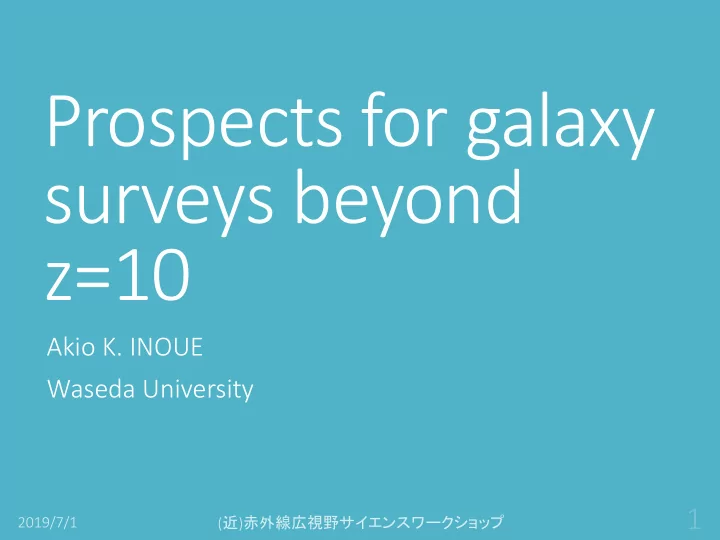

Prospects for galaxy surveys beyond z=10 Akio K. INOUE Waseda University
Contents 1. Cosmic dawn and highest-z observations 2. Empirical evolution model of UV luminosity functions 3. Expected UV luminosity functions and surface densities of galaxies at z>10
Cosmic dawn GN-z11 (z=11.2, Oesch+16) MACS1149JD1 (z= (z=9.11, , Ha Hashimoto+18) EGSY8p7 (z=8.68, Zitrin+15) GRB 090423 (z=8.2, Tanvir+09) GRB090429B (z=9.4, Cucchiara+11) ULAS J1342+0928 (z=7.54, Banados+18) NAOJ One of the most important themes in modern astronomy and astrophysics is to understand the galaxy formation. The current frontier redshift is about z=10 and our observations will reach the Universe beyond z=10, the pre- reionization epoch, in near future.
Highest emission line redshift object Hashimoto+AKI+18, Nature [OIII] 88 μm line at z=9.1096
Formation at z~15 Hashimoto+AKI+18, Nature Balmer break → Age of a few 100 Myrs → Formation at z~15! SFR~10 Msun/yr at z~12-15 → m ~26-27 AB Very easy to be detected with JWST.
Massive BBGs at z~6 Mawatari, AKI+19, submitted Balmer break galaxy (BBG) candidates at 5<z<8 selected by using the deepest wide NIR imaging data.
Cosmic SFRD at z>14 Mawatari, AKI+19, submitted The stellar mass density requires a significant star formation rate density in an earlier epoch, that is, z>14. 99.7% confidence area
Observed UV luminosity functions UV luminosity functions (LFs) of Lyman break galaxies (LBGs) have been observed up to z~10. Possible redshift evolutions of the number density (φ*) and the faint - end slope (α). Bouwens+15
Empirical number density evolution log 10 𝜚 ∗ Mpc −3 mag −1 = −0.25 1 + 𝑨 − 1.5 (for z>3; solid) log 10 𝜚 ∗ Mpc −3 mag −1 = −0.6 1 + 𝑨 + 1.65 (for z>8; dashed) ∗ 𝑁 𝑉𝑊 = −20.5 (fixed) 𝛽 = ቊ−2.0 (𝑨 < 9) (𝑨 ≥ 9) (fixed) −2.3
UV luminosity functions at z~8 Filled circles & thin solid line: Bouwens+15 Filled triangles: Stefanon+19
UV luminosity functions at z~9 Filled circles: Bouwens+16 Open circles: Oesch+13 Filled triangles: Stefanon+19 Five-pointed stars: Morishita+18
UV luminosity functions at z~10 Filled circles & thin solid line: Oesch+18 Five-pointed stars: Morishita+18 Red bars: Finkelstein+19
Bright-end of UV LFs at z>8 A time-independent excess??? Filled circles & thin solid line: Oesch+18 Filled triangles & open squares: Stefanon+19 Five-pointed stars: Morishita+18 Red bars: Finkelstein+19 Small crosses: Matsuoka+18
Expected surface number density JWST Dark/light shades: ULTIMATE-Subaru ULTIMATE Subaru surveys Dotted lines: JWST surveys Solid lines: Smooth density evolution models Dashed lines: Rapid density evolution models
Expected surface number density JWST Dark/light shades: ULTIMATE-Subaru ULTIMATE Subaru surveys Dotted lines: JWST surveys Solid lines: Smooth density evolution models WFIRST Euclid Dashed lines: Rapid SN Deep Deep density evolution 5deg 2 , models 40deg 2 , H<28.2 H<26.0 𝜇 𝑀𝑧𝛽 = 1.95 𝜈𝑛 @ 𝑨 = 15 WFIRST HLS 2000deg 2 , H<26.7
Expected surface number density The case with a time-independent bright-end excess JWST WFIRST Euclid 𝜇 𝑀𝑧𝛽 = 1.95 𝜈𝑛 @ 𝑨 = 15
Expected surface number density The case with a time-independent bright-end excess JWST WFIRST Euclid 𝜇 𝑀𝑧𝛽 = 1.95 𝜈𝑛 @ 𝑨 = 15
Expected surface number density The case with a time-independent bright-end excess JWST WFIRST Euclid 𝜇 𝑀𝑧𝛽 = 1.95 𝜈𝑛 @ 𝑨 = 15
Summary ⚫ Expected UV luminosity functions of galaxies up to z=15 were presented, assuming an empirical galaxy number density evolution. ⚫ Expected detectability of galaxies at z=10 to 15 in JWST, ULTIMATE-Subaru, Euclid and WFIRST surveys was presented. ⚫ There may be a bright-end excess in UV luminosity functions, which was inferred from recent z=8-10 LBG and z=6 BBG observations.
Recommend
More recommend